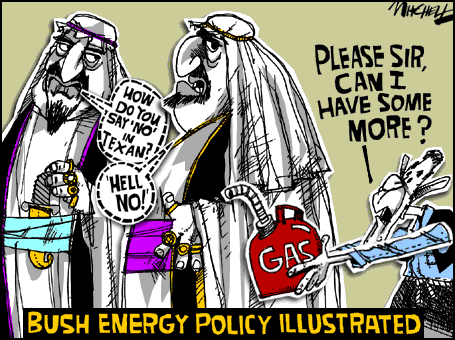Buffalo Roam,
We have more demand then ever before, and production as barely increased in the last 3 years, yet demand keeps going up exponentially. We have been search for crude all over the world, it never stopped, rather we have been finding less and less and we are now at a point where the new mines and wells that are coming online are only managing to cover the production loses of the old oil fields. There is not enough left to explore and find, your argument is equivalent saying "well if we just search for more continents we will find another!"
As for experience, What use did the USA experience in Vietnam come to in NOT getting into another one? None, experience is useless if its the wrong experience of if it is not interpreted correctly.
It will take as long to build the factors for algae as it would take to build shall oil extraction or coal to liquid plants, point is conventional oil is depleting, we are going to need new infrastructure anyways, why should we make it in another limited resource, especially if that resource is harder utilize and more polluting than another alternative?
Really yet we have enough production for the speculators to buy up 850 milliom more barrels than last year?
"The issue is: who's driving up the price? And it's not the oil companies," said Michael Masters, a hedge fund manager.
Masters blames it on a new class of speculators led by pension funds and university endowments, which are buying up huge amounts of oil, nearly 850 million barrels more a year than they did just 5 years ago. That nearly matches the growth in Chinese demand, which is often blamed for rising crude prices
Production of new well is increasing, but again it is capacity to do so that is lacging behind,
U.S.-Cuba Security Cooperation - World Security Institute
Drilling will most likely not begin until 2008 due to a tight market for deep-sea exploration rigs as the world's search for oil intensifies under pressure ...
http://www.wsicubaproject.org/energychron06.cfm
China Confidential: August 2006
China also agreed to build 13 oil drilling rigs and 18 oil tankers for Venezuela. ...... Secretary of State Condoleezza Rice has successfully sidelined Vice ...
http://chinaconfidential.blogspot.com/2006_08_01_archive.html
Here it is;
(FORTUNE Magazine) – EVER SINCE crude was discovered at Titusville, Pennsylvania, 134 years ago, U.S. oil producers have been a source and symbol of American industrial prowess. Five of the great Seven Sisters were American. Texas wildcatters drilled the U.S. until it became the biggest oil power in the world, then moved on to the Middle East and made Saudi Arabia the champion. Oceangoing roustabouts from south Louisiana opened up the North Sea oil and gas fields. Now this quintessentially American industry is leaking away like oil into sand. Domestic crude production has been shrinking by roughly 3% a year since 1986. Only about 700 drilling rigs are out exploring, compared with more than 4,500 in 1980.
In 1980 we had 4.500 oil rigs on line, that number had shrunk to 700 rigs by 1983, by 2005 we were at 2026 rigs available for drilling, that is a 50% decrease in rigs available for exploitation of discovered field.
Utilization of rig fleet tightens significantly
Significant gains were made in US and Canadian land fleet sizesand utilization, spurring rig construction. Tracked for the first time,international markets saw growth in utilization, while the global offshore fleet experienced a tightening of numbers.
Steve Berkman and Tory Stokes, ReedHycalog, Houston
Record oil and gas prices during the past year resulted in a dynamic rig fleet, according to the 52nd annual ReedHycalog Rig Census. The number of available rigs in the US and Canada rose again this year. The US rig fleet was up about 2%, and the Canadian fleet gained 9%, compared with 2004. However, the census indicates that the global, offshore mobile fleet decreased 10%. Fleet utilization during the spring census period tightened in all areas, with US utilization now reaching levels common in the early 1980s.
.The US fleet had a net gain of 38 units this year, expanding to 2,026 rigs from 1,988. This net increase results from 211 rig additions and 173 deletions during the past year, Fig. 1.
.The largest gain to the US fleet, 124 units, was due to rigs brought back into service after being inactive. However, a large number of rigs, 133 units, was removed from service, offsetting this gain.
.The number of US rigs meeting the census definition of "active" was 1,920. This compares to 1,674 last year, an increase of 15%.
.US rig utilization shot up to 95% this year from 84% in 2004, Fig. 2.
.Based on recent US activity, day-work contracts continue to be the most prominent of all drilling contracts at 82%, gaining an additional five percentage points since last year.
.The number of US drilling contractors increased by 13 this year to 226, as more companies found it economically viable to operate rigs.
.Contractor survey results indicate that 77 refurbished and 73 newly manufactured units will enter the market during the next 12 months.
.Canada's rig fleet reached another record high, up to 741 units from 680.
.This includes 43 newly manufactured rigs that were additions to the census.
.Canadian utilization climbed to 74% from 66% during the spring census period.
.The global, offshore mobile fleet decreased 10% this year, to 641 rigs versus 673 units in 2004. This decline was due primarily to rigs removed from service, due to long-term inactivity and cold-stacked status.
.Global, offshore mobile utilization rose to 85% in 2005, from 72% in 2004.
.Outside the US and Canada, utilization was 83% in 2005, with the Middle East showing the highest utilization rate for land rigs at 94%.
A Shortage of Capacity!





